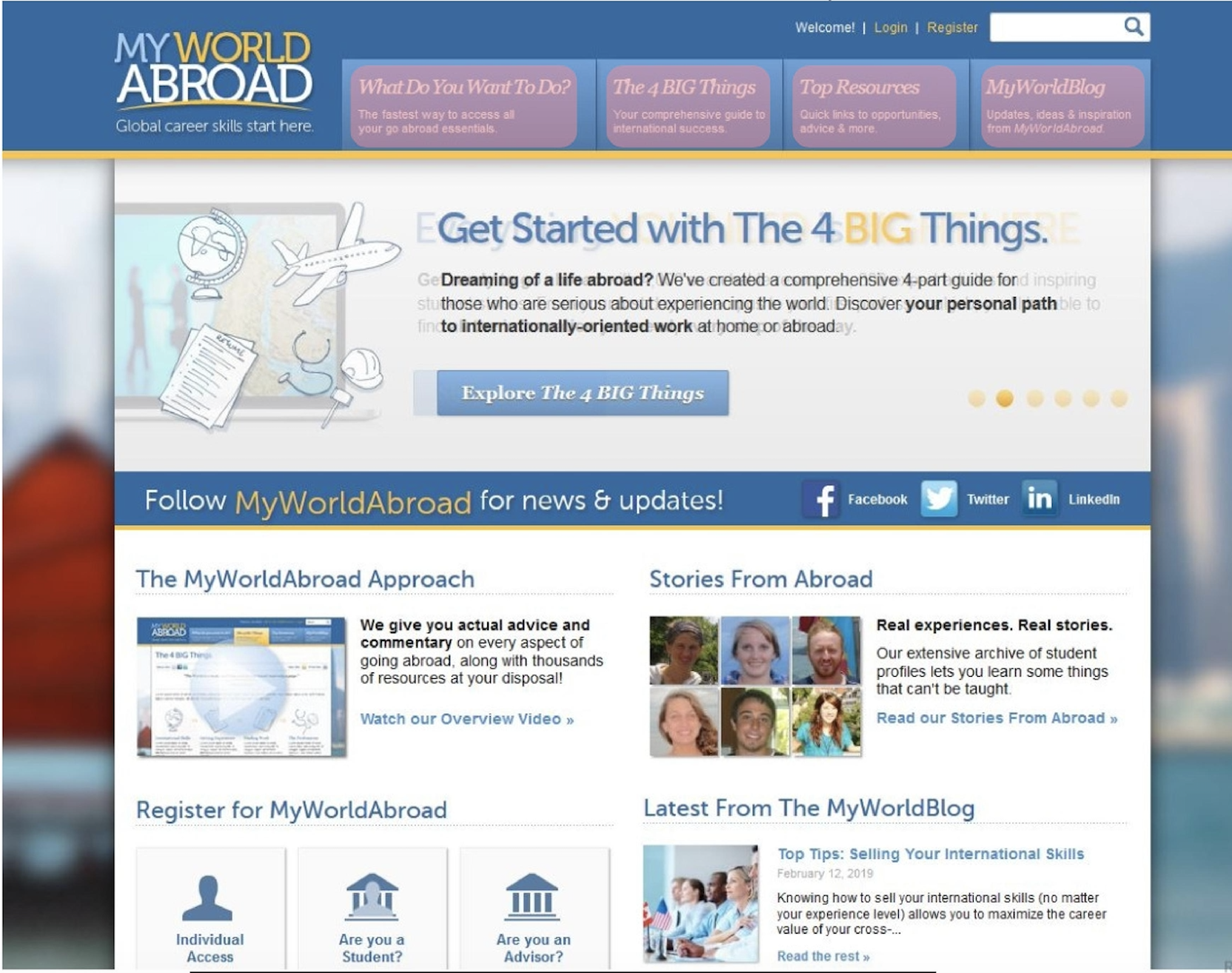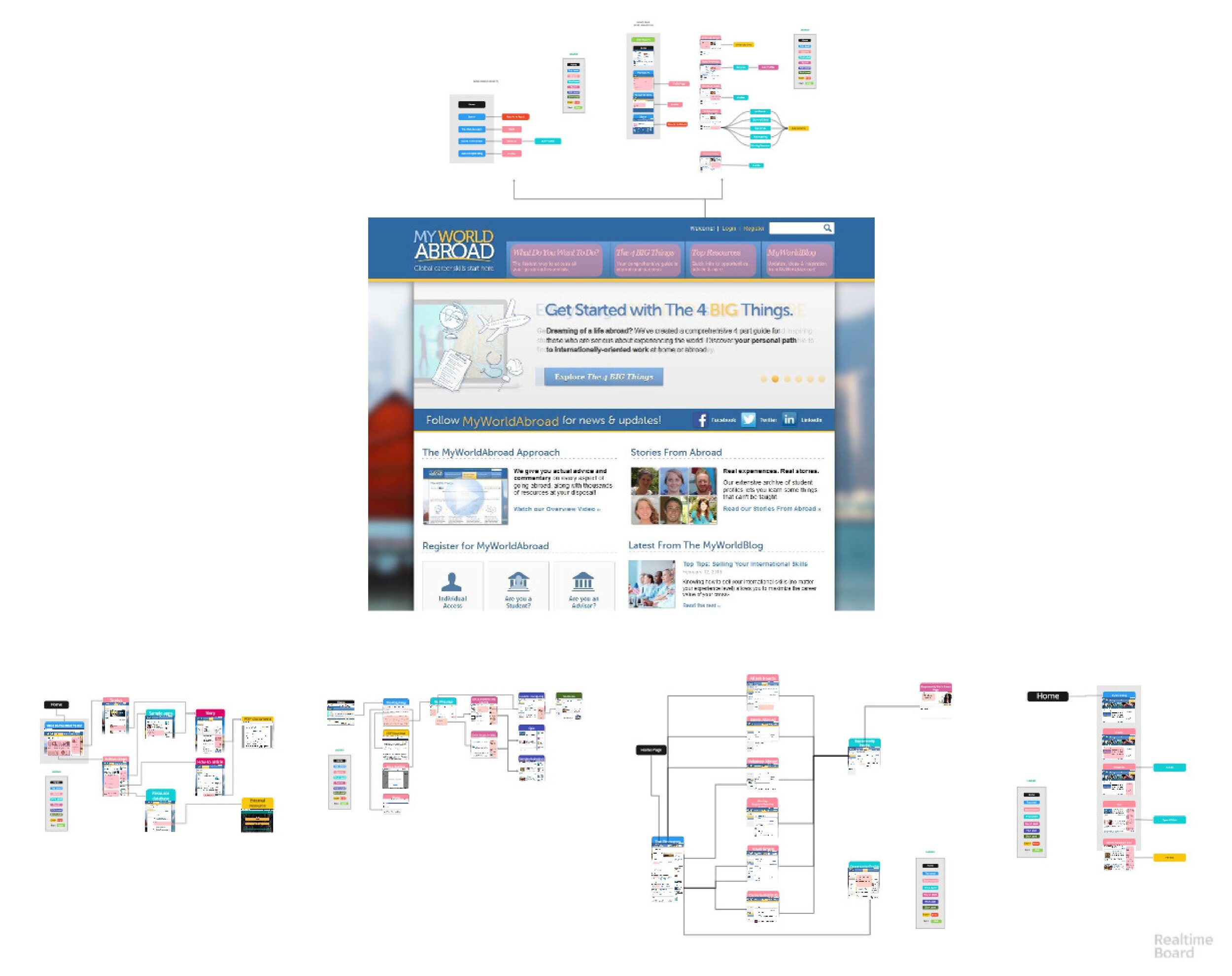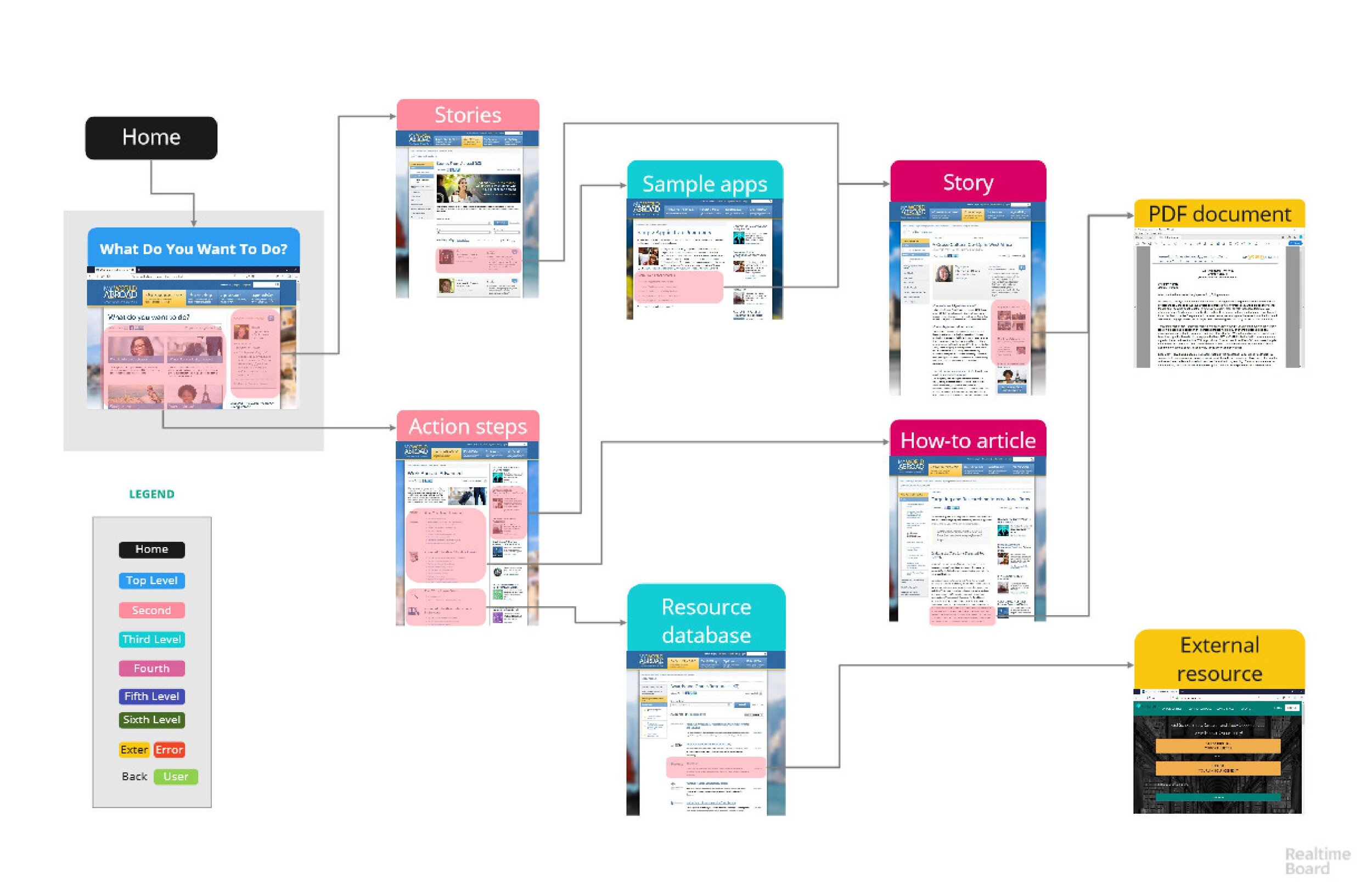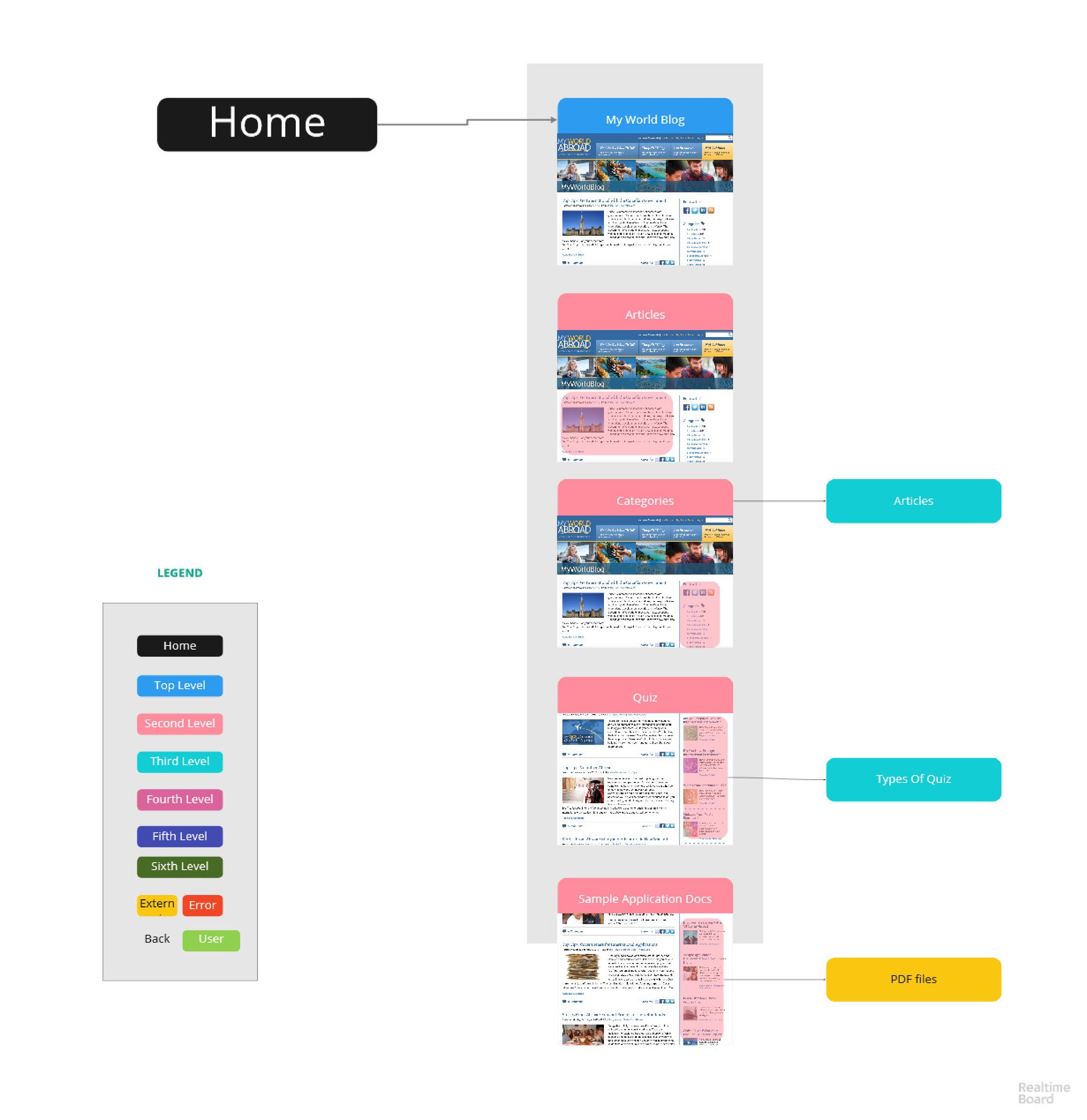MyWorldAbroad Website and User Engagement
BACKGROUND
BACKGROUND Information
MyWorldAbroad is a comprehensive international career skills resource catering primarily to North American colleges and universities. It has 300 articles containing guidance, advice, and sample documents, as well as a database of approximately 4,000 resources such as job boards, internship programs, and organizations to help prepare students to work in a global economy. Founded by Jean-Marc Hachey, the website is modeled after his book The Big Guide To Living And Working Overseas.
MyWorldAbroad, a business-to-business (B2B) company, offers its most popular content in a wide variety of formats, tailored to various uses, such as quick guides, visual guides, quizzes, postcards, and social media campaigns, all on its website.
PROJECT DESCRIPTION
In 2019, MyWorldAbroad started experiencing client attrition (i.e. decreasing subscriptions and general engagement) and some level of disconnect from its users. Mr. Hachey thought about implementing a plan for creating a mobile app in order to increase subscriptions and user engagement. He originally tasked our team with helping to develop that implementation plan. However, in order for the team to explore that idea, we first needed to analyze the desktop platform to figure out problems and pain points in the most relevant routes and sections, including navigation issues and the information hierarchy.
ROLE
I formed part of a four-person UX research team called edXperience. Each one of us participated in conducting research for each of the methods applied. In two of those methods, I served as a project manager, however of those two only one is detailed in this online research report. The project manager role entailed:
Leading in setting up the logistics for that method (e.g., developing documents, setting up lab space)
Heading the project planning, scoping, and design meetings
Writing most of the analysis of the report for that research method
Collecting the different parts of the final report from my team members, collated those different parts into a final report, and edited that report
Making a short presentation for the research method and final their results
RESEARCH GOALS
research Goals
edXperience was tasked with two broad goals:
Assessing the needs of users of MyWorldAbroad, including different needs of different groups
Evaluating the usability of the website for a variety of purposes.
RESULTS
RECOMMENDATIONS
We considered all our findings gathered from all our different methods, and synthesized them into the four most important and the most actionable recommendations:
Create a “Visual Guide” for navigating the site and make it the landing page for every new user
Replace the label “Job Boards” with a more accurate label like “Organizations” to prevent user confusion and to prompt users to focus on other things
Redesign the main navigation bar to include drop-downs so that users can hover over possible choices before clicking
Remove all article hooks in the sidebar, with the exception of Student Stories, so that users can focus on the main content of each page
LIMITATIONS
While there were many limitations in our processes, the limitations below were some of the most noteworthy:
When conducting the heuristic evaluation, the team only did the job boards section and not other parts of the site, which limited our analysis.
A low response rate to the surveys could mean that our results are not representative of MyWorldAbroad’s user base.
The short data collection time frame of about four months limited our results.
The founder of the organization was the main stakeholder from MyWorldAbroad that we had access to, which means that we only received his general assessment of the problem and only his feedback on our research
METHOD/PROCESS
DISCOVERY
In order to understand the problem(s) that we faced, we held a stakeholder interview/conversation with Mr. Hachey. Where he informed us about the
history of MyWorldAbroad
demographics of its user base
general market that MyWorldAbroad lies in
connection between MyWorldAbroad and the book that it is based on
MyWorldAbroad staff and team
philosophy about career development and searching for international career opportunities
USER COMMUNITY and persona
MyWorldAbroad’s two primary user communities are:
University Students
Student users are undergraduate and graduate students at colleges and universities all over North America. Most of the student users can speak at least a second language (in addition to English) and have moderate financial resources to help them go abroad. Most students are interested in studying or gaining experience and skills, and quite a few want to explore cultural heritage, work, or just get away.
University Study Abroad Advisors & Career Counselors
Advisors work in the career centers or study abroad offices of the universities that subscribe to MyWorldAbroad. They are dedicated to helping students advance their careers and go abroad. They work at small, medium, and large universities all over Canada and the U.S.
Photo by Andrea Piacqu adio from Pexels
Photo by Mateus Campos Felipe on Unsplash
Persona
The team developed three personas. The persona of the university career advisor below was developed by me.


INTERACTION MAP
Interaction mapping involved:
Tracing user pathways through the website
Representing the path in a 2D space
Analyzing the potential problems and pain points








The images above represent the interaction of the different pages in the MyWorldAbroad. Marcus mapped the interaction of the Top Resources page but also assisted with mapping the interaction of the Home Page (Default). We as a team analyzed all of the interactions.
FINDINGS
By doing an interaction map of the four main tabs: A) What Do You Want to Do?, B) the Four Big Things, C) Top Resources, and D) MyWorldBlog, we observed that:
MyWorldAbroad contained an abundance of information on individual pages
The desktop site has numerous links that connect the different pages of the site to each other
There’s a lack of onboarding (such as a road map) for the users to know how to navigate the site
There is a lot of clicking around before the user reaches the key content.
INTERVIEWS
Interviewing was the way we sought to understand the needs and perceptions of one of the key user communities: the advisors. We chose them because they were the stakeholders that opted to use MyWorldAbroad for years to come. We 1) recorded the interviews, 2) transcribed the recordings and 3) analyzed the transcripts with thematic codes
Interviewee Details:
Total interviews 6
Moderate users 2
Heavy users 4
Different universities 6
FINDINGS
Once we got a feel for the interaction flow and navigation of the site, then we needed to know how the stakeholders engaged with the site. In other words, we needed to speak to the college and career counselors (one of the user communities) who use the site most regularly and who recommend the site to students.
What we learned from the career counselor confirmed and expanded on the team’s first impression about how large the website was and how complex it was to navigate it.
Finding 1: Many of the interviewees expressed that the parts of the website they found most important, were not easy to get to from the home page.
Finding II: Added to this, the counselors found it difficult to navigate the website so they often got frustrated while trying to get to the parts of MyWorldAbroad that they found useful and important.
Finding III: The counselors highlighted that they felt overwhelmed by the amount of content on each page, noting that the sidebar had attention-grabbing headlines that made them unsure of what to focus on.
COMPARATIVE EVALUATION
To understand how MyWorldAbroad fared against other resources for international study and work, five entities were selected that either compete with MyWorldAbroad or service as a point of comparison. These five entities fell into the categories of either: Direct competitor, indirect competitor, partial competitor, parallel comparisons, analogous systems.
The key observations were about the audience, purpose, and features of these competitors to create seven dimensions that illuminate strengths of MyWorldAbroad or areas for improvement. These dimensions were:
Filtering and searching
Social media engagement
Organization of information
Breadth of resources
Depth of resources
Clarity of headings, titles, and labels
Look and feel.
FINDINGS
Using the seven dimensions MyWorldAbroad was found to measure well in breadth and depth of resources since the site provides many different types of resources as well as a number of thoughtful pieces of advice emerging from Mr. Hachey’s unique approach for global career hunting. However, we found several ways that MyWorldAbroad could learn from its competitors.
Comparative evaluation chart comparing MyWorldAbroad with other competitor entities across seven different dimensions.
SURVEY ANALYSIS
The main quantitative method was a survey of students, using Qualtrics, of both frequent and infrequent users in equal numbers. In this survey, we wanted to gain insight into the student users of MyWorldAbroad. We split our target population of student users into two groups by frequency of use.
Frequent users were defined as the 500 users who had the most sessions on the website in the past six months (of when the survey was conducted), with a minimum of four sessions.
Infrequent users were defined as the 300 most recent one-time users (of when the survey was conducted).
Versions of the same questionnaire were sent to each population via the survey tool Qualtrics.The survey collected three types of information: characteristics, attitudes, and behaviors. By linking these points we could begin to see how each type of student thinks about and behaves with the website.
Draft document outlining the survey questions to be asked to the survey respondents about MyWorldAbroad (MWA), organized by characteristics, attitudes, and behaviors of the target student users.
FINDINGS
86 responses were received where 39 of the responses were from frequent users and 47 were from infrequent users. The survey analysis found that:
Students reported that job boards were one of their top targets, confirming what many of the career counselors suspected
Students’ reasons for going abroad was to gain experience and skills
Students who went abroad or were interested in going abroad had interests in politics and government, community and social services, international development, and law.
HEURISTIC EVALUATION
Four evaluators checked the features of an important page, the job boards list, against a well-known set of heuristics, Jakob Nielsen’s Ten Heuristics in chapter two of Usability Inspection Methods book. Each problem was given a severity ranking, ranging from 0 to 4. These heuristics were the guiding force that enabled the time to evaluate the different job and resource boards on the MyWorldAbroad site.
FINDINGS
At this point, we needed clarity as to whether the site aligned with the basic principles of user experience design. This led us to perform a heuristic evaluation of the site employing the standards developed by leading user experience pioneer Jakob Nielsen. The most salient findings were:
Finding I: Access to content via the search bar in the job boards is difficult. This is in part due to the lack of consistency on the site including visual aspects that are not consistent with most search interfaces.
Finding II: It is hard to tell the difference between “All Job Boards” and “General Job Boards.”
Finding III: The visual appearance of the layout reduces user engagement. Many elements of the site need to be removed, minimized, or streamlined to achieve better aesthetics.
Moderated USABILITY TEST
The final data collection exercise was a mixed-methods test of the usability of MyWorldAbroad. The three criteria used to recruit students were 1) student status 2) interest in going abroad, and 3) no prior experience with MyWorldAbroad.
In total 5 usability tests were conducted including 1 pilot that aimed at testing the main features of MyWorldAbroad. An effort was made to recruit 5 users who fit the “graduate students looking for avenues to work abroad” customer profile. The participants were all graduate students who are currently or soon to be job hunting students looking for opportunities to work/study abroad.
The users were asked to complete three tasks:
Access a “Visual Guide”
Find a job that matches certain specifications
Find student stories
Visual guides were chosen because MyWorldAbroad has actively promoted them, so real MyWorldAbroad users might be told about visual guides by their advisors. The job search was meant to test one of the most common goals of users of MyWorldAbroad. And the story search was meant to test other navigation and search features of the site.
FINDINGS
Through the five usability tests conducted (two of which Marcus conducted), we identified some of the key pain point points of the website. Observing users not only how they behaved during the usability test but also in what they verbalized helped us get into the minds of the users while they engaged with the MyWorldAbroad website.
Finding I: Despite how useful and rich the visual guides were, they were virtually impossible to find directly on the site. They could not be found on the home page of MyWorldAbroad either. Users went to several pages to find anything that looked like visual guides, including exploring the tab Top Resources.
Visual guides are not present in the footer of the home page where most pages in MyWorldAbroad can be found.
Finding II: In order to locate the visual guides, all of the users ended up searching for the visual guides in the search feature where they located them but the users were thrown off by the HTML tags that showed up in the results.
FINDING III: User Stories always remained in the peripheral vision, so they were easy to find. Most test users spotted stories in the upper-right side pane, which had pictures of people’s faces. The stories could be found either by searching or browsing.
LEARNING AND NEXT STEPS
User Expectation vs. Mr. Hachey’s Approach (MyWorldAbroad’s Philosophy)
Throughout our research, we noticed that there is a larger issue underlying the user experience at MyWorldAbroad. While users expect to find direct access to jobs on the site, the founder of MyWorldAbroad, Mr. Hachey, has a vision of educating users in his signature approach to internationally oriented careers.
Most North Americans who want to work abroad, think they need to write a country-specific resume/job application materials and apply to jobs in that country with organizations based in that country. However, Mr. Hachey has found that most North Americans who actually work abroad, do so with companies based in North America. This implies that job hunters should focus on those North American organizations with international placements.
Clarifying the Purpose of Job Boards
Users come to MyWorldAbroad to find specific jobs located abroad, but Mr. Hachey offers a list of North American organizations, on MyWorldAbroad, that he knows are best to target in the job search even if they don’t have jobs posted. The label “Job Boards” turns out to be point of confusion. We suggest that in the new site visual guide, a clear graphic should be included that conveys Mr. Hachey’s signature strategy for how North Americans can obtain internationally-oriented jobs.











